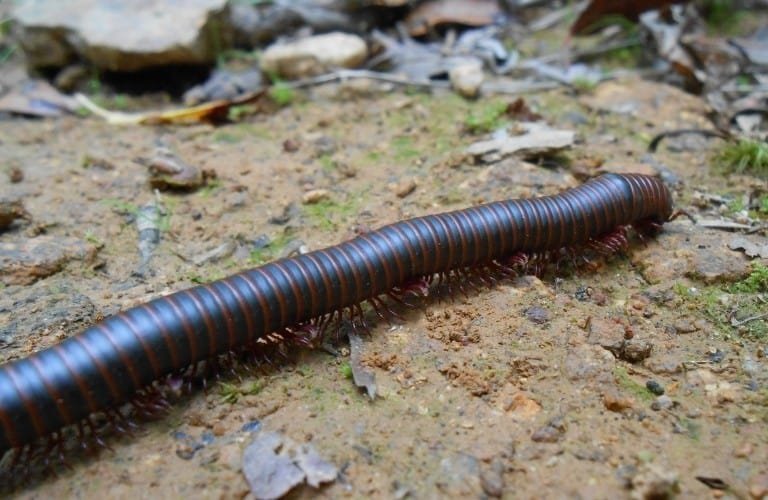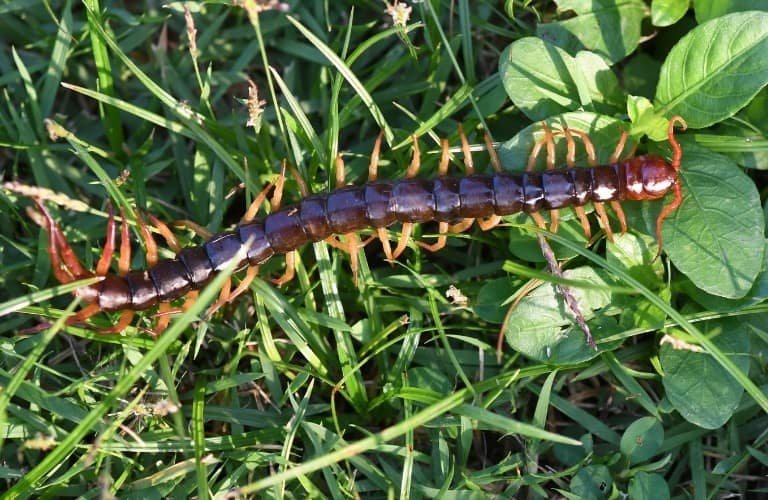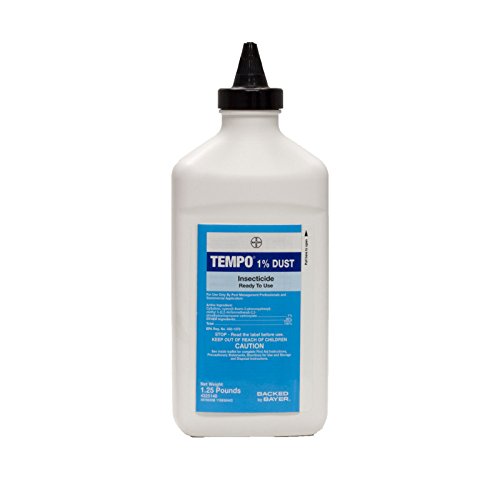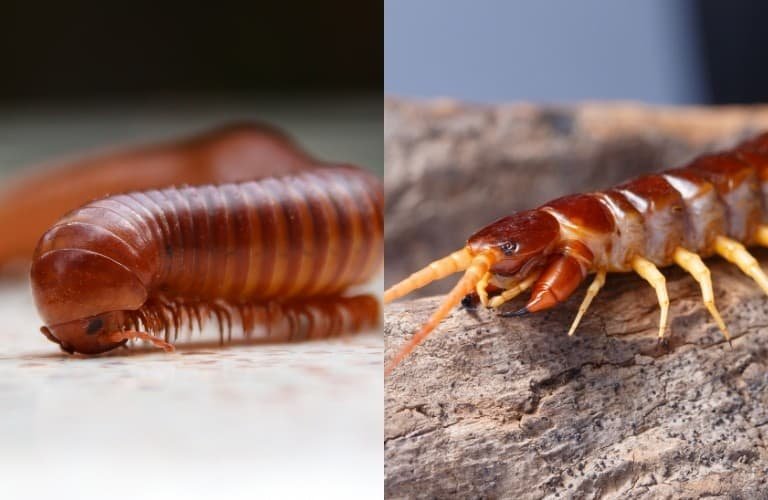Millipedes are creepy, crawling bugs that are unsightly and unattractive.
If their outdoor population grows too big or the conditions are unfavorable, they might try to get into your basement, crawlspace, or home.
How can you get rid of millipedes? Eliminate millipedes by removing food sources, keeping dry conditions, and attracting natural predators. Natural insecticides containing essential oils may work but may not be as effective as chemical products, such as residual sprays, dusts, and granules.
Identification
Millipedes are segmented arthropods, which means they have a hard exoskeleton divided into multiple segments down the length of the body.
They have two pairs of legs per segment, except for the first three segments, which each have only one pair of legs.
Most common millipedes range from light brown to black in color. Typically one or two inches long, millipedes generally have twenty or more segments.
Millipede legs are positioned underneath the body, which is almost perfectly cylindrical.
They are classified as myriapods, which literally means “10,000 feet,” though the most legs ever recorded on a millipede is 750.
Millipede Behavior
You can typically identify millipedes by their movements.
Unlike centipedes, millipedes move slowly and are better suited for burrowing and digging in the soil. Their legs move in a wavy, fluid motion.
Reproduction and Defense
To reproduce, millipedes lay eggs in dark, humid, safe places that are far from their predators. Incubation period is a few weeks, and a female lays anywhere from 10 – 300 eggs at a time.
Millipedes are preyed upon by many birds, frogs, snakes, and some carnivorous insects.
When threatened, millipedes curl up into a ball to allow their exoskeleton to protect themselves.
They can also emit a cyanide-like liquid that can scare off predators. This substance can cause minor irritation to human skin and eyes.
Diet
Millipedes primarily eat decaying plant material, making them detritivores.
They are considered useful for the soil (very similar to earthworms) because they speed up the decaying process for the organic matter.
They help aerate the soil, allowing oxygen to get to root systems and plants.
Need for Moisture
The right amount of moisture is important for millipedes, as they cannot survive in environments that are too dry or too wet.
This is one of the main reasons that millipedes will enter your home: to find moisture or to escape the saturated ground.
Where You’ll Often Find Millipedes
If millipedes are in your home, it is typically because the soil outside was too dry or too wet to sustain their needs.
Thus, you might find millipedes in dark, humid parts of your home or basement.
Even when inside your home, millipedes will seek to avoid predators by hiding in cracks and crevices.
Occasionally, millipedes will mistakenly get into home pools.
Thinking this is water that they need to survive, they will crawl (or fall) into pools.
Because millipedes are not built to swim well and cannot breathe underwater, they drown within a few minutes.
Due to their diet and need for plenty of moisture, you will typically find millipedes outdoors in locations where these things are readily found.
Areas with compost piles, dead leaves, grass clippings, wood stacks, garbage, mulch, untreated wood, or animal waste are havens for millipedes.
Read more about what attracts millipedes to your yard in this article.
If you have ever lifted a garden paver off the ground or bark off of rotting wood, you might have seen several millipedes.
These bugs love the protection from predators and easily accessible food found in these places.
Commonly Mistaken Pest: Centipede
Millipedes and centipedes are commonly confused due to their similar body shape, numerous legs, and similar names.
However, these are two distinct animals with distinct looks, diets, habits, and needs.
Appearance
While millipedes have two pairs of legs per body segment, centipedes only have one.
Centipedes are flatter and less cylindrical, and their bodies are more flexible. This allows them to move more quickly.
A general rule of thumb is that if a many-legged bug moves quickly and runs away when threatened, it is a centipede; if it moves slowly and curls up into a spiral when threatened, it is a millipede.
Other Differences
The centipede’s waxy layer of exoskeleton allows them to retain water more easily, making it less essential that centipedes live in humid environments.
Thus, there are species of centipedes that live in desert ecosystems.
Centipedes are carnivores, which mean they consume other animals for nourishment. Centipedes eat spiders, other centipedes, and smaller arthropods.
They use their maxillipeds (appendages on their first segment) to grip their prey before injecting it with venom and consuming it with their strong jaws.
Because centipedes are more aggressive than millipedes and have the ability to bite, you should not attempt to pick them up or handle them.
Their bite and venom can feel similar to a bee sting.
If you need to be able to determine whether the pest inside your home is a millipede or centipede and don’t want to count the number of legs, watch the behavior and locomotion.
If it tries to flee, moves quickly, and is flexible, it is probably a centipede. If it curls into a coil, is more rigid, and moves slowly, it is likely a millipede.
Removal Methods
| Method | Time Involved | Estimated Cost | Natural |
| Remove food sources | 1 – 2 hours | Free | ✅ |
| Dehumidifier | 1 day | $150 | ✅ |
| Redirect water | 5 minutes | $10 | ✅ |
| Attract predators | varies | $50 | ✅ |
| Natural insecticide | 15 – 30 minutes | $15 | ✅ |
| Residual insecticide | 15 – 30 minutes | $10 | |
| Insecticide dust | 15 – 30 minutes | $30 | |
| Granules | 15 – 30 minutes | $10 | |
| Water-soluble powder | 15 – 30 minutes | $20 |
The Best Way to Eliminate Millipedes
For millipedes, like many other home pests, it is best to prevent them from entering in the first place.
However, if they have already invaded your home and you need to get rid of them, use a vacuum cleaner to suck them up.
The heat and dryness will kill them quickly.
Millipedes secrete a cyanide-like liquid when threatened, so it is best not to touch them if possible.
This substance is not life-threatening, but it might cause a reaction on human skin or in the eyes.
Basic Guidelines
As previously mentioned, the best offense against millipedes is a good defense.
In other words, the best way to eliminate them from your home is to prevent them from entering in the first place.
Millipedes eat decomposing organic matter, so keep their food sources away from your foundation:
- Compost piles.
- Garbage.
- Mulch.
- Leaves.
- Grass clippings.
- Firewood stacks.
- Untreated wood.
If it is impossible to move these materials away from the foundation, at least try to raise them up off the ground.
Also:
- Use appropriate weather stripping for all exterior doors in your home. Make sure all doors and windows are sealed properly.
- Locate and seal potential cracks on the exterior of your house. Though millipedes are small and crafty, you might be able to determine their entry point and then close off their access.
Keep in mind that the goal should not be to completely eradicate millipedes from your yard, as they serve an important biological role.
Rather, focus your efforts on keeping them out of your house and away from your home’s foundation.
Natural Solutions to Get Rid of Millipedes
In a world already inundated with chemicals, natural solutions should always be your first plan of treatment, especially for indoor use.
Indoor Infestations
If you have tried to prevent the entrance of millipedes but they have still made it into your home, there are some natural remedies you can use.
Again, millipedes are not necessarily dangerous, but they are unsightly and creepy and can be taken care of rather easily.
Remove Food Sources
The reality is that millipedes are not particularly hardy and cannot survive in adverse conditions.
So, one of the best ways to naturally get rid of these bugs is to allow them to die by removing their food sources and eliminating the moisture they need.
Make sure that there is no decaying organic material in your home, such as dead flowers, rotting food, indoor compost bins, etc.
If you have indoor plants that are attracting the millipedes, consider lifting them off the ground to make them difficult to reach.
Remove Moisture From Your Home
Keep your home as dry as possible.
One of the reasons millipedes enter houses in the first place is because they cannot get the moisture they need from outdoors, so they seek areas with plenty of water.
Millipedes cannot survive more than a couple of days without the right amount of moisture in their habitat.
Quickly dry places with standing water or puddles, and consider using a dehumidifier in any areas of your home with high humidity.
Waykar 40 Pint Dehumidifier is capable of removing up to 5 gallons of moisture from the air per day in rooms up to 2,000 square feet.
Simply set your desired humidity level, and the sleek machine will take care of the rest.
A drain hose over 6 feet long is included so you can empty the water collection bucket easily.
Additionally:
- Caulk or seal any cracks in the foundation or exterior that might allow water to get into the home.
- In times of heavy rain, make sure your basement or crawl space is kept dry.
- Repair any faulty plumbing, drippy faucets, leaky pipes, overflowing air conditioning condensers, or other sources of moisture.
These things will keep basements moist and attract millipedes.
Also, be sure to divert rainwater and snowmelt away from the house’s foundation by using gutter drainpipe extensions.
This will generally help keep the basement and foundation area dry.
Frost King Tilt N’ Drain Extender directs water farther away from your foundation by increasing the downspout length up to 6 feet.
It works perfectly with both 3 inch and 4 inch downspouts and can swivel 180°, giving you complete control of water flow direction.
Outdoor Infestations
As already mentioned, millipedes are generally good for the soil. They consume and digest organic matter which can help your lawn and garden.
However, there are certain situations in extremely dry environments in which millipedes can be detrimental to young plants.
Occasionally millipedes will use the roots of these plants to obtain the moisture they need to survive.
Additionally, a massive number of millipedes can be detrimental to yards and gardens as they will harm grass and plants.
In these situations, you might want to restore the millipede population to a healthy number.
Keep Lawn Watered
Make sure your lawn or garden is well watered and moist so the millipedes do not have to seek moisture from your plants.
The goal is to satisfy the millipedes so that they aerate and nourish the soil instead of eating the plant roots.
Keep young plants in planters off the ground to keep them away from millipedes. Make it difficult for the bugs to get to the root system.
Introduce and Welcome Predators
Attract birds that prey on millipedes, such as wrens and robins, to your yard. with bird feeders and birdbaths.
These birds listen and feel for millipedes and worms under the ground and then use their beaks to dig them out of the soil.
Twinkle Star Panorama Birdfeeder is a gazebo-style hanging feeder that will attract a wide variety of birds as long as you keep it filled with yummy birdseed.
With six feeding ports, a wide feeding tray, tiny circular perches, and a sloped roof for shade and weather protection, birds of all kinds will be flocking to your yard.
VIVOHOME Antique Birdbath is a lightweight, attractive birdbath in a European style that features a bronze patina finish with a hollow base.
The hollow base can be filled with gravel for stability, or you can use the three included ground stakes to firmly anchor it in place.
Though potentially an extreme step, you could raise chickens and allow them free reign in your yard or garden.
Similar to wrens and robins, these birds will kill and eat millipedes and other pests.
Check your city regulations to ensure chickens are permitted in your area.
Use a Natural Insecticide
If you are looking for outdoor, natural insecticides that are safer to use than potentially harmful chemicals, you’re in luck!
There are a variety of liquid products that connect to a hose end and will not harm pets, lawns, or gardens.
Might Mint Yard Bug Spray is classified as a minimum-risk product and is completely natural. Mighty Mint is a company that specializes in family-friendly, home-safe pesticide products.
This spray connects to a hose for ease of application. In addition to millipedes, the Yard Bug Spray works on ants, flies, fleas, mosquitoes, and ticks.
Pesticide Solutions to Get Rid of Millipedes
If the other recommendations listed above have not worked or are unrealistic, you might consider using pesticide solutions to get rid of millipedes.
For instance, if you have a dirt floor in your basement or are not responsible for the exterior of your building, you may wish to resort to pesticides.
In “Best Insecticides for Millipedes,” you’ll learn about the different types of pesticides that will safely eliminate millipedes and what to look for when choosing an insecticide.
Here are some products that will be helpful.
Residual Insecticide: Ortho Home Defense
Residual insecticides are long-term solutions to pest problems, as they retain their potency for a period of time.
They kill bugs and pests when they land on or crawl over the surface.
Ortho Home Defense is odorless, dries clear, is stainless, is water resistant, and is non-irritating.
It kills a variety of pests besides millipedes, making it versatile enough for many problems.
As long as the label directions are followed, it is safe for pets. It should be applied to entryways, windows, and perimeters of homes.
Insecticide Dust: Tempo 1% Dust
Dust insecticides are designed to fill hard to reach places. They are designed to be used in cracks, crevices, entry points, and other hiding places.
Because millipedes burrow and often enter through cracks in foundations and exteriors, this type of product can be useful.
When millipedes try to sneak into your home through these cracks and crevices, they are killed by the insecticide in the dust.
Dust insecticides are typically used for bees, wasps, hornets, and other flying pests, though they work on any type of bug.
These products work best with a duster tool, which is essentially a bellows that shoots the dust into the area.
The difficulty with this type of product is that you must know where and how millipedes are entering your home, which is not always readily apparent.
Tempo 1% Dust is incredibly effective, permanently preventing millipedes and other bugs from entering.
For use in both indoor and outdoor settings, Tempo 1% is odorless and nonstaining.
With a hand duster, it can be applied underneath baseboards and foundation cracks, eliminating most of the points of entrance for millipedes.
If applied correctly and left undisturbed, Tempo 1% can retain its potency for one year.
Outdoor Granules: Ortho Home Defense Granules
Rarely is there an indoor infestation of millipedes without an outdoor abundance.
So, if you find yourself in a situation where you need to eliminate millipedes from your yard or garden, consider using an outdoor granular pesticide.
This product is so named because it comes in a granular, gritty form. It is applied using a hand spreader or fertilizer.
Ortho Granules begin to work in minutes and can be effective for up to three months.
It will not damage your yard and is safe for pets and humans as long as it is applied correctly.
Water-resistant and hardy, this granular pesticide provides widespread protection against a variety of damaging bugs and pests.
Water-Soluble Powder: Demon WP
One of the most tried and true methods of eliminating pests outdoors is to spray them with powerful chemicals.
This can be used as a perimeter application (to prevent pests from getting inside the perimeter) or as a spot application.
Generally, these require a multi-purpose hand pump sprayer for application.
Demon WP is a powerful powder that must be mixed with water. It kills on contact and works on a wide variety of pests.
It can be used in cracks and crevices in addition to popular millipede areas such as compost piles, wood stacks, garbage areas, and grass clippings.
Safety Precautions When Using Pesticides
When using pesticides or any other chemical, always closely follow label instructions.
Keep out of the reach of children and pets, and do not ingest or inhale any pesticide.
Be sure to read any warning label that comes with the product, and wear all recommended personal protective equipment.
If any chemical is ingested, immediately contact your local poison control center (1-800-222-1222).
When to Call a Professional Exterminator
Because millipedes are not hardy, dangerous, or aggressive, professional exterminators are rarely necessary.
However, if you find yourself in a situation where you cannot take care of the issue yourself, exterminators would be able to quickly solve the problem.
If you have exhausted all other options or if your living situation dictates that you cannot use any self-applied pesticides, a professional exterminator might be the best option.
Before spending money on a professional, be sure to first check with our entire selection of millipede articles to find answers to your questions and solutions to the problem.














